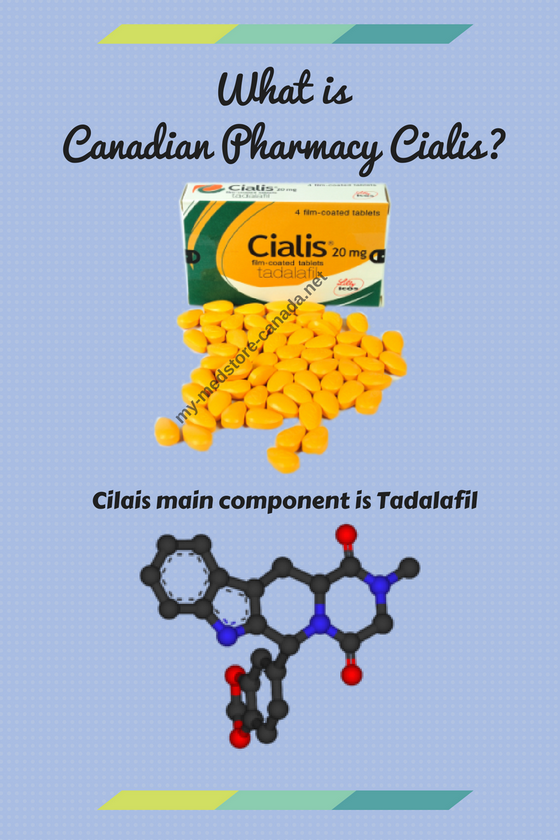What is Generic Cialis Online?
Cialis is drug directed to eliminate any manifestations of erectile dysfunction. It is possible to treat this disorder due to effective medication. The main component of the drug is tadalafil 20 mg.
[ithshop code=”cialis” tpl=”short” page_id=”2190″ dummy=”txt”]
Pharmacological Effect
Cialis is erectile dysfunction treatment drug. This drug is a reversible selective inhibitor of specific phosphodiesterase type 5 (PDE5). When sexual stimulation causes local nitric oxide release, inhibition of PDE5 leads to increased levels of cGMP in cavernous body. The result is a relaxation of smooth muscles of arteries and blood flow to penile tissues that causes an erection. The agent has no effect in absence of sexual stimulation.
Studies in vitro have shown that Cialis is a selective inhibitor of PDE5 found in:
- corpus cavernosum smooth muscle;
- blood vessels internal organs smooth muscle;
- skeletal muscle;
- platelets;
- kidneys;
- lungs;
- cerebellum.

Its action on PDE5 is more active than another phosphodiesterase. Cialis is 10 000 times more active against PDE5 than against FDE1, PDE2, PDE4, which are located in the heart, brain, blood vessels, liver and other organs. Tadalafil blocks 10 000 times more active PDE5 than PDE3 an – enzyme that is found in heart and blood vessels.
This selectivity for PDE5 compared to PDE3 is important because PDE3 is an enzyme participating in heart muscle reduction. In addition, the drug approximately 700 times is more potent for PDE5 than for PDE6, found in the retina and is responsible for photographic transmission. The drug is also 10 000 times more active against PDE5 compared with its effect on FDE7-FDE10.
The drug improves an erection and the possibility of successful sexual intercourse.
Cialis effect lasts up to 36 hours. The effect is already apparent after 16 minutes after taking the drug in presence of sexual excitement.
In healthy men, the medication does not cause significant changes in systolic and diastolic blood pressure compared with placebo in a prone position (mean maximum decrease of 1.6 / 0.8 mm Hg, respectively) and standing (mean maximum decrease of 0.2 / 4.6 mm Hg, respectively). Tadalafil does not cause significant changes in heart rate. Tadalafil does not cause changes in color perception (blue/green), due to its low affinity for PDE6.
In applying this medicament, the daily dose of the drug is 10 mg. There is no clinically significant effect on the drug and number of sperm concentration, motility, and morphology of spermatozoa.
Pharmacokinetics
Absorption
Tadalafil is rapidly absorbed. Average Cmax is achieved after 2 hours. The rate and extent of absorption are independent of food intake. Time of intake (morning or evening) had no clinically significant effect on rate and absorption extent.
Pharmacokinetics in healthy individuals is linear with respect to time and dose. In the dose range from 2.5 mg to 20 AUC increases proportionally with dose. Css plasma is reached within 5 days of taking the drug at 1 time/day.
Pharmacokinetics in patients with erectile dysfunction is similar to pharmacokinetics in patients without erectile dysfunction.
Distribution
Vd is about 63 liters, indicating that Cialis is distributed in body tissues. At therapeutic concentrations, 94% of tadalafil is bound to plasma proteins. In healthy persons, less than 0.0005% of the administered dose was found in semen.
Metabolism
Tadalafil is metabolized with the participation of isoenzyme – CYP3A4. The major circulating metabolite is a catechol-methyltransferase inhibitor. It is 13,000 times less active against PDE5 than tadalafil.
Therefore, this metabolite is unlikely to be clinically significant.
Excretion
In healthy individuals, average clearance of the drug is of 2.5 l / h and average T1 / 2 -. 5.17 hours. The agent excretes primarily as inactive metabolites, mainly with feces (about 61%) and to a lesser extent with urine (about 36%).
Special clinical situations
Healthy elderly people (65 and over) have a low clearance, which was reflected in an increase of AUC by 25% compared with healthy people aged 19 to 45 years. This difference is not clinically significant and does not require a dosage adjustment.
In patients with mild renal insufficiency (creatinine clearance 51-80 ml/min) or moderate (creatinine clearance = 31-50 ml/min), AUC is greater than in healthy individuals. Protein binding is not changed when impaired renal function. In patients with severe renal insufficiency (creatinine clearance <= 30 mL/min), use of Cialis has not been studied.
The pharmacokinetics of tadalafil in patients with mild hepatic impairment is comparable with that in healthy individuals.
In patients with diabetes mellitus, AUC was lower during Cialis treatment by about 19% than in healthy individuals. This difference is not clinically significant and the dose does not require changes.







